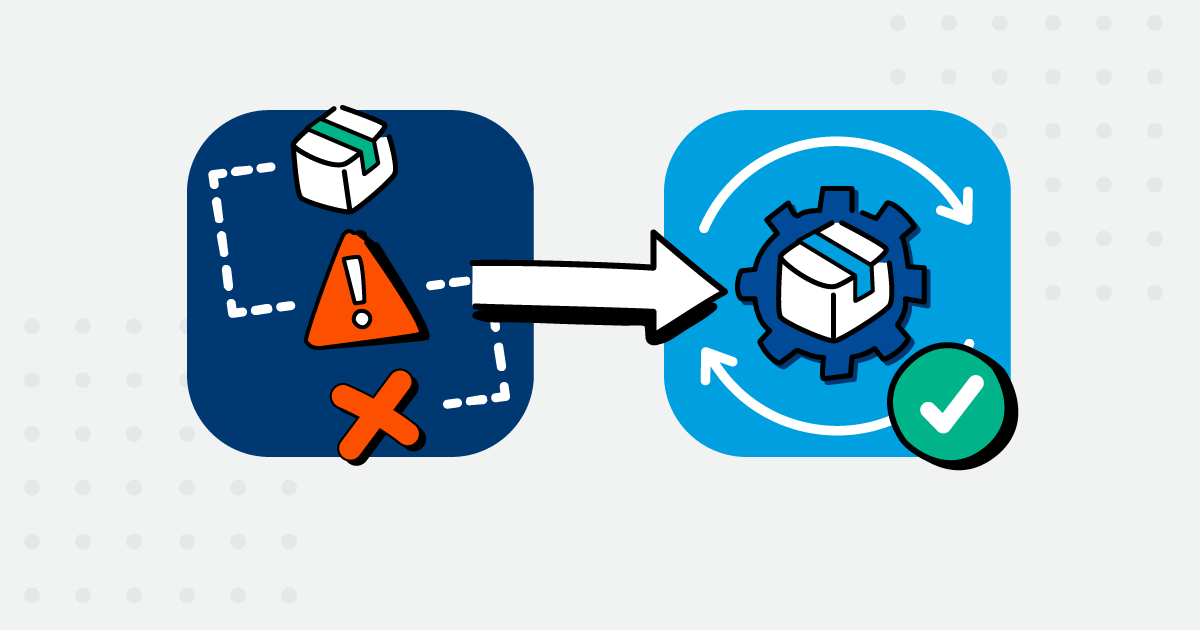
How automation transforms retail operations: From chaos to clockwork
Imagine a retail operation that runs like a well-oiled machine, where automation streamlines processes, data empowers smart decisions and staff work seamlessly together. This isn't a futuristic fantasy; it's the reality achievable through the retail efficiency revolution.
In this blog post, we'll delve into some key areas that can be transformed: supply chain, inventory management and staff scheduling. We'll explore how automation, data-driven insights, and strategic collaboration can revolutionise your operations, leading to:
- Increased Efficiency: Reduce errors, streamline processes, and free up valuable time and resources.
- Reduced Costs: Optimise inventory levels, minimise storage needs, and make smarter staffing decisions.
- Enhanced Customer Satisfaction: Deliver faster order fulfilment, ensure product availability, and provide a consistently positive in-store experience.
Let’s explore the strategies and tools that can take your business from chaos to clockwork.
Quick links 🔗
1. Optimising the Supply Chain: The Efficiency Engine of Retail2. Inventory Management: From Stockpiles to Streamlining orders
3. Staff Scheduling for Efficiency
“Automation is a game changer for improving efficiency in retail,” says Kye Bessant, our Solutions Architect from Modern Visual.
“By automating tasks in the supply chain, inventory management and staff scheduling, you’re not just saving time and money – you’re creating a foundation for a truly customer centric experience."
"Reduce your wait times, have shelves that are always stocked and employees empowered to focus on building relationships with customers. That’s the power of automation - it benefits everyone.”

Kye Bessant, our Solutions Architect from Modern Visual.

1. Optimising the Supply Chain: The Efficiency Engine of Retail
Warehousing and logistics are undergoing a transformation and automation is at the forefront. Here's how:
- Improved Picking Accuracy: Robotic arms and automated storage and retrieval systems (ASRS) minimise errors in picking orders. Your customers receive the correct items every time, fostering trust and satisfaction.
- Speedier Deliveries: Conveyor belts and automated sorting systems can significantly accelerate order fulfilment. This gets products to your customers faster, exceeding their expectations and keeping them coming back.
- Reduced Labour Costs: While automation requires an initial investment, it can free up your manpower for higher-value tasks and streamline overall operations. In the long run, this translates to significant cost savings.
Data: The Fuel for Smart Decisions
Data is the lifeblood of a modern supply chain. Analysing historical sales data gives you valuable insights:
- Predict Demand: Forecast what your customers will buy and when, ensuring you have the right stock levels to meet their needs. This helps avoid stock outs and wasted resources, optimising your inventory management.
- Optimise Inventory Levels: Data analytics can help you determine the optimal amount of stock to hold, minimising storage costs and preventing unnecessary overstocking.
Tools of the Trade:
Several tools can empower you to make data-driven decisions:
- Forecasting Software: These powerful tools analyse historical data and market trends to predict future demand with greater accuracy.
- Real-Time Inventory Tracking Systems: Gain instant visibility into your stock levels across all locations, allowing for proactive reordering and preventing stock outs.
Stronger Together: Collaboration with Suppliers
A smooth-running supply chain relies on strong relationships with your suppliers. Collaborative forecasting and planning (CF&P) is a strategy where you work together with your suppliers to:
- Improve Communication: Regular communication ensures you're both on the same page regarding demand forecasts and production schedules. This minimises disruptions and allows for a more agile response to changing market needs.
- Enhanced Responsiveness: By working collaboratively, you can anticipate potential disruptions and adapt your plans accordingly. This ensures a more responsive supply chain, allowing you to react quickly to market fluctuations and customer demands.
These strategies optimise your supply chain for maximum efficiency, reduce costs, and ultimately, deliver a better experience for your customers.

2. Inventory Management: From Stockpiles to Streamlining orders
The Perils of Excess Inventory:
Ever feel like you're drowning in stock? This becomes stressful if you then need to sell your stock at a discounted rate, risk losing profits and have a higher risk of damaging or missing stock. Excess inventory is a silent thief, draining your cash flow and gobbling up valuable storage space. Overstocking or not forecasting your predicted sales accurately will hinder your ability to effectively run your inventory effectively. Let's delve into the dangers of overstocking:
- Cash Flow Crunch: Unsold inventory ties up your cash, hindering your ability to invest in other areas of your business. This can limit your growth potential and overall financial health.
- Storage Struggles: Excess stock requires additional storage space, which translates into extra costs. This can significantly impact your profitability, especially in prime retail locations with high rental fees.
- Carrying Costs Creep Up: Don't underestimate the hidden costs of holding onto excess inventory. These "carrying costs" include storage fees, insurance, and potential spoilage or obsolescence. Minimising them is key to a healthy bottom line.
Just-in-Time (JIT) Inventory: A smoother Approach with accurate sales forecasting
Imagine having the right amount of stock at the right time. Enter Just-in-Time (JIT) inventory management. This revolutionary approach minimises storage costs and keeps your cash flow healthy.
Accurate sales forecasting is the bedrock of efficient inventory management. Analysing historical sales data, alongside factors like seasonality and marketing initiatives, allows you to predict future demand with greater accuracy. This ensures you hold optimal stock levels, preventing costly stock outs and excess stock. Having the right amount of inventory on hand helps meet customer needs, without the burden of surplus stock eroding your profits. Sales forecasting empowers you to achieve this ideal balance, guaranteeing a streamlined and cost-effective inventory management system.
Here's why it's a game-changer:
- Reduced Storage Costs: By holding less inventory, you free up storage space, leading to significant cost savings. This allows you to invest those resources back into your business.
- Improved Cash Flow: With less money tied up in inventory, your cash flow improves. This empowers you to invest in other areas like marketing, promotions, or product development.
- Enhanced Efficiency: JIT encourages tighter integration with your suppliers, leading to a more streamlined operation. This translates to faster response times and better customer satisfaction.
However, a word of caution: JIT relies heavily on reliable suppliers who can deliver stock promptly. Building strong supplier relationships is crucial for the successful implementation of JIT.
Technology to the Rescue
Streamline your inventory tracking with the help of modern technology:
- Barcode Scanners: Ditch the manual counting! Barcode scanners provide quick and accurate inventory data, saving time and minimising human error.
- Inventory Management Software: Invest in software that automates inventory tracking, purchase orders, and low-stock alerts. This frees up your team's time and ensures you always have the right stock levels, preventing costly stock outs.
By embracing innovative inventory management strategies and leveraging technology, you can transform your stockroom from a cluttered liability to a well-oiled engine of efficiency.
3. Staff Scheduling for Efficiency: The People Powerhouse
Your staff is the heart of your operation. Scheduling them effectively ensures you have the right people in the right place at the right time. This maximises productivity, ensures smooth customer service, and ultimately, boosts your bottom line.
Empowering your staff with the right technology is key to boosting efficiency and morale. You can replace tedious manual tasks with user-friendly software. Inventory management software can automate stock checks and purchase orders, freeing up valuable time for staff to focus on higher-level tasks like customer service or product displays.
For example: a sales associate equipped with a mobile point-of-sale (POS) app. This app allows them to complete transactions anywhere on the shop floor, eliminating the need for long queues and keeping customers happy. By investing in efficient software solutions, you're not just saving time; you're creating a work environment where employees feel valued and equipped to excel, ultimately leading to a happier and more productive workforce.
Here's how to achieve staffing efficiency:
Workforce Optimisation: Scheduling Made Smart
Gone are the days of clunky spreadsheets and guesswork. Workforce optimisation software is here to revolutionise your scheduling process. This powerful tool helps you:
- Schedule Based on Demand: Leverage historical data and sales forecasts to create schedules that perfectly match your customer traffic patterns. No more overstaffing during quiet periods or understaffing during peak hours.
- Automated Scheduling and Task Management: Bid farewell to tedious manual scheduling. Workforce optimisation software can automate the process, freeing up your valuable time for other priorities. Additionally, it can manage task assignments, ensuring everyone knows exactly what they need to do.
Cross-Training: Building a Versatile Team
Empower your employees by giving them the gift of cross-training. This means training them in a variety of tasks and areas of your business. Here's why it's beneficial:
- Operational Flexibility: Cross-trained staff can seamlessly cover for colleagues who are absent or take on additional tasks during busy periods. This keeps your operations running smoothly and ensures customers receive excellent service even when things get hectic.
- Employee Engagement: Learning new skills keeps your team engaged and motivated. They feel valued and have the opportunity to develop their skillsets, fostering a positive work environment.
Motivation Matters: A Happy Workforce is a Productive Workforce
A happy and motivated team is key to achieving long-term efficiency gains. Here's how to cultivate a thriving workforce:
- Performance Recognition: Acknowledge and celebrate your employees' achievements. This fosters a sense of accomplishment and motivates them to go the extra mile.
- Competitive Compensation: Offering competitive compensation packages demonstrates that you value your staff and are committed to their well-being. This helps attract and retain top talent, contributing to long-term efficiency.
By implementing these strategies, you can transform your staff scheduling from a headache to a strategic advantage. You'll have a team that's efficient, empowered, and dedicated to delivering exceptional customer service.

Optimise, Automate and Thrive: The Future of Retail is Now
The future of retail is clear: it's streamlined, data-driven and efficient. By embracing retail efficiency strategies, you can optimise your operations, automate tedious tasks, and unlock a future of success. This blog post has provided a roadmap for implementing key strategies in your supply chain, inventory management and staff scheduling. These strategies will lead to significant cost reductions, happier customers and a flourishing retail business.
Don't stop now. Keep learning
 What is HubSpot? A Complete Guide for Enterprise Businesses
If you’ve ever felt like your marketing, sales and service tools are scattered across too many...
What is HubSpot? A Complete Guide for Enterprise Businesses
If you’ve ever felt like your marketing, sales and service tools are scattered across too many...
 How to clean data in Excel before Switching CRMs
Excel can be a powerful tool for cleaning data before migrating to a CRM system. Many businesses...
How to clean data in Excel before Switching CRMs
Excel can be a powerful tool for cleaning data before migrating to a CRM system. Many businesses...
 WordPress vs Content Hub (HubSpot)
How to pick the right platform for your business: Both WordPress and Content Hub are powerful...
WordPress vs Content Hub (HubSpot)
How to pick the right platform for your business: Both WordPress and Content Hub are powerful...


